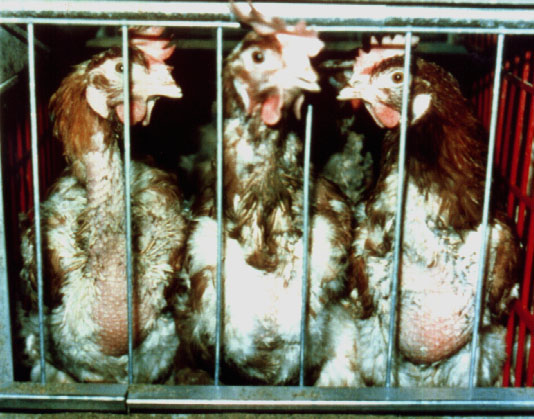FORCED MOLTING of Laying Hens: Tell the Egg Industry to STOP

Molting refers to the replacement of old feathers by new ones. In nature, birds replace all of their feathers in the course of a year to maintain good plumage at all times. A natural molt frequently happens at the onset of winter, when nature discourages the hatching of chicks. The hen stops laying eggs and concentrates her energies on staying warm and growing new feathers.
The egg industry artificially manipulates this natural process by forcing an entire flock to molt simultaneously, normally after 10 months of relentless egg production. This is done to impose uniformity of production and reduce the amount of time the hens are not laying eggs. It is used as an economic tool to renew shell quality in exhausted hens when it is deemed cheaper to "recycle" them rather than immediately slaughter them after 40 or so weeks of constant egg-laying on a calcium-deficient diet.
To force the hens to molt, their food is entirely removed or nutritionally reduced for an average of ten days. Donald Bell, the University of California architect of forced molting, urges complete feed removal for no less than five days. Water removal, drugs, and artificial dark-light manipulation may also be used. The hens abruptly shed their feathers and stop laying eggs for one or two months, instead of the normal three or four. The survivors may be force-molted two or three more times, based on economics. This is a major method of regulating supply and demand and reducing the cost of feeding the hens. At any given time over 6 million hens in the U.S. are being systematically starved in their cages (98% of U.S. laying hens are in battery cages) and in "free-range" confinement sheds.
Dr. Peter Dun, a researcher from Scotland, said hens are force molted in the U.S. "until their combs turn blue"--or they die.
What Can I Do?
-
DEMAND A BAN. In 1994, Joy Mench, a poultry researcher, warned a meeting of the Egg
Association of America that "in terms of public sentiment," the U.S. industry needs to look at
forced molting. She noted that "in Europe, feed restriction is limited to one day because of stress
to the birds."
Contact:
United Egg Producers
1303 Hightower Trail. Suite 200
Atlanta, Georgia 30350
Fax: 770-587-0041
Website: www.unitedegg.org
Email: info@unitedegg.org
U.S. Poultry & Egg Association
1530 Cooledge Road
Tucker, Georgia 30084-7303
Fax: 770-493-9257
Website: www.poultryegg.org
Email: webmaster@poultryegg.org
Egg Industry Magazine
Attn: David Amey, Editor
Watt Publishing Co.
122 South Wesley Avenue
Mt. Morris, Illinois 61054-1497
Fax: 205-739-6945
Email: amey@wattca.mhs.compuserve.comRequest replies.
-
In addition to targeting the industry and educating others in daily life and through media contacts, the single most important thing each of us can and must do is to stop purchasing poultry and eggs, including processed foods that include poultry and egg ingredients – "chicken broth," egg whites, and other hen horrors. Forced molting is not confined to battery hens. So-called "free-range" hens and breeder fowl are subjected to the practice, as well. Wash your hands of eggs, egg whites, and poultry products.